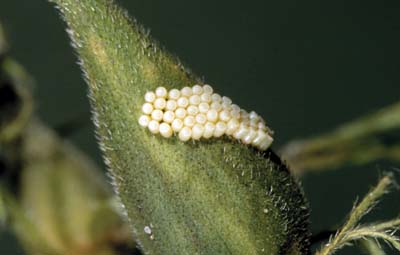To save the Web-optimized images shown below to your hard drive:
|
Click to access Display and Print quality images. |
The southern green stink bug feeds on many different plants. It has piercing-sucking mouthparts and may damage foliage or fruits. It may also transmit bacterial spot of tomato when feeding on tomato plants. Economic thresholds are available for many crops that are attacked by southern green stink bug, so control measures may be applied at the correct time. Biological control is helpful when managing the population, but may not provide sufficient control under all situations. The use of trap crops, especially early plantings, is a common management technique that is employed when southern green stink bug is expected to be a problem.
Images
To save the Web-optimized images shown below to your hard drive:

Eggs of southern green stink bug, Nezara viridula.
(Photographer: J. Castner, University of Florida)
Click to access Display and Print quality images.
|
Click to access Display and Print quality images. |
|
Click to access Display and Print quality images. |